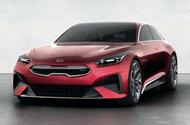Matt Prior: Coupes and wagons will soon replace SUVs

Kia’s 2017 Proceed concept could be an ‘after-SUV’ sales hitDemand for SUVs is continuing to grow, but industry insiders are already preparing for the next big bodyshape
Engaging discussion on the Peugeot 508 launch with CEO Jean-Philippe Imparato, whose company’s money is made mostly via SUVs these days.
In fact, 60% of its profits come from tall vehicles. Most of the rest is from commercial vehicles.
Interesting idea he floated, though. He says that the 508 was always going to still be offered as an estate (no big surprise there) but that the focus had been on making it a good-looking, rakish kinda thing. A shooting brake/break/whatevs sort of set-up, because “in the coming five years, you’ll see a business’s fleet which have 10 SUVs available”, he said.
Kia Ceed GT shooting brake due next year as new range topper
An SUV has become the premium, you see – and the trend isn’t yet going away – but when everybody’s got one, is it the premium choice any more?
“We are trying to invent the after-SUV,” he said. Not today, not tomorrow, but he can perceive a time – “maybe five years” – when the tide begins to turn.
He’s not alone. Kia’s product planning chief Artur Martins said on the Ceed launch: “The buyers who bought the first SUVs, some of those are going to go back to a four-door coupé, which is a more emotional product.”
Like Peugeot, Kia is eyeing up capitalising on these too. It has already shown us the Proceed concept, a very dynamic, attractive piece of kit. A production version could be quite the thing, in the way that Mercedes has a pretty sleek A-Class-based wagon already.
SUVs aren’t going away, yet: sales keep building. But car makers always want to identify the next trends. And, after 2020, when meeting emissions targets becomes harder and harder, the appeal, for manufacturers, of moving people away from tall vehicles with extra weight and a big frontal area into something more sporting and dynamic will be obvious.
And I, for one, will be delighted. I know, it’s good to like all cars because second-class driving is still better than first-class public transport (more on which in a moment), but little SUVs and crossovers are by far my least favourite types of car. They are heavier, worse-handling and worse-riding than their hatchback or saloon equivalents and with precious little gain in off-road ability, which is never put to use anyway. Most times I drive one, I come away thinking: “Why wouldn’t you just buy the hatchback?” Apart from being more pothole immune, anyway. Anyway, perhaps one day soon, I’ll be able to replace “just buy the hatchback” with “buy the really great-looking wagon” and people will listen.
On the theme of second-class driving being better than a first-class alternative, then, comes the annual Department for Transport (Df T) report on journey times.
When it comes to ‘access to key local services’ – workplaces, schools, GPs/hospitals, food shops and town centres – the DfT found that these were, on average, 18 minutes away by public transport or walking, 15 minutes on a bicycle, or 11 minutes in a car. Another report found that a morning commute into English cities – the sort of thing that should, typically, be well served by public transport – was on average 36 minutes quicker by car than by bus or train. I know we should drive less. I know we should emit less.
But the car just works when the alternatives, so often, do not.
Read more
Comments
Post a Comment